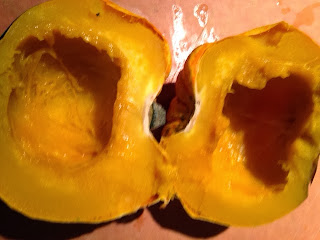One of my favorite squash options is sweet dumpling squash. It is so beautiful and naturally sweet. Just roast it, mash it up and voila - you have a yummy side dish for your holiday meal! I concocted a cranberry balsamic kale salad to serve on top that complements the squash nicely, adds some holiday charm and delivers a blast of phytonutrients & antioxidants to boot!
Roasted Sweet Dumpling Squash
Ingredients
- 1 sugar dumpling squash
Preparation Instructions
- Wash and place on a baking sheet.
- Bake at 400 degrees F for 1 hour.
- Cut in half, scoop out seeds and discard.
- Scoop out flesh and mash.
Serving Suggestion
- Top with pumpkin seeds and dried cranberries to bring in extra crunch and sweetness while adding some holiday color to the dish.
 |
| Cut in half after roasting. |
 |
| Scoop out seeds and discard. |
 |
| Mash up flesh. |
 |
| Top with pumpkin seeds and dried cranberries. |
Cranberry Balsamic Kale
Ingredients
- 1 bunch lacinato kale (~4 cups, finely chopped & packed)
- 1 cup fresh cranberries
- 1/8 cup balsamic vinegar
- 1/8 cup honey
- 1 cup walnuts
Preparation Instructions
- Finely chop kale into thin slices like confetti.
- Soak cranberries in boiling water for 10 minutes.
- Put soaked cranberries, balsamic & honey in a food processor and blend until smooth.
- Toss kale with dressing & add walnuts.
Fuel Facts
Numbers: 40 calories, 1 g protein, 0 g fat, 9 g carbs, 1 g fiber
**For 1 cup mashed sugar dumpling squash
Numbers: 245 calories, 6 g protein, 16 g fat, 23 g carbs, 5 g fiber
**For 1/4 recipe (~1 cup) of Cranberry Balsamic Kale
Ingredient Breakdown:
v
Winter
Squash – Varieties of winter squash include delicata, acorn, kabocha and sugar dumpling.
Winter squash are one of the top food sources of carotenoids, antioxidants that
promote eye health and boost the immune system. One cup of winter squash also
provides about one-third of the recommended daily intake of vitamin C. Delicata
& kabocha squash have skin that can be eaten when cooked, making it easy to
prepare and enjoy.
v
Kale –
You won’t here me use the word “super” food very often, because I believe all
foods contribute their own, unique healing powers. That being said, if there
was one food to eat more of, it would be kale. Studies continue to show kale’s
ability to lower the risk for cancer, prevent inflammation and even act as a
detoxifier at the genetic level. Bottom line… eat more kale.
v
Cranberries
– The berries get their beautiful color from anthocyanins, phytonutrients in
the flavanoid category. Cranberries contain several other phytochemicals as
well, all of which may have anti-inflammatory and antioxidant properties.
The acidity of cranberries has long been
credited for their ability to prevent urinary tract infections (UTIs). However,
recent studies have shown that this may be due to the content of another
phytonutrient, proanthocyanidin (PAC). PAC may prevent bacteria from attaching
to the urinary tract lining which in turn protects against UTIs. Researchers
believe this same anti-bacterial effect may help prevent the development of
stomach ulcers.
vVinegar – Research has shown vinegar to play a role in regulating spikes in
blood glucose. One study showed a 50 percent reduction in post-prandial (after
eating) blood sugar when diabetic patients consumed vinegar before a
carbohydrate rich meal. This translates to non-diabetics as well. By
maintaining steady blood sugar levels we are able to sustain energy and prevent
hunger, important for just about anyone who leads an active life.
v
Honey –
Due to the combination of glucose and fructose, honey will keep you energized
longer than it’s sweet counterparts. Glucose is used quickly by the body,
providing an immediate energy source. Fructose takes longer to absorb, sustaining
blood sugar levels. When blood sugar is kept stable, your energy will also
remain constant, so say goodbye to the afternoon crash.
Honey is also a great natural healer. For
starters it is packed with polyphenols, antioxidants that have immune boosting
properties to keep you from becoming sick. In addition, honey contains an
enzyme that produces hydrogen peroxide which is why it is believed to be
antibacterial in nature. Honey can be used topically to treat burns, wounds,
and even acne. Honey fights off impurity-causing bacteria while also hydrating
the skin.
v
Walnuts
– These are the only nuts that are a significant source of omega-3 fatty acids, containing 2.5 grams
per ounce. Strong evidence exists to support the role of omega 3 fatty acids in
lowering the risk for heart disease and preventing inflammation. A number of
studies have also found benefits in relation to mood, brain function and
healthy skin.








Ooooh! You could also use the salad as the base and then cube the squash to add to the salad for a slightly different texture.
ReplyDeleteI LOVE it! Will try next time I make it :)
Delete